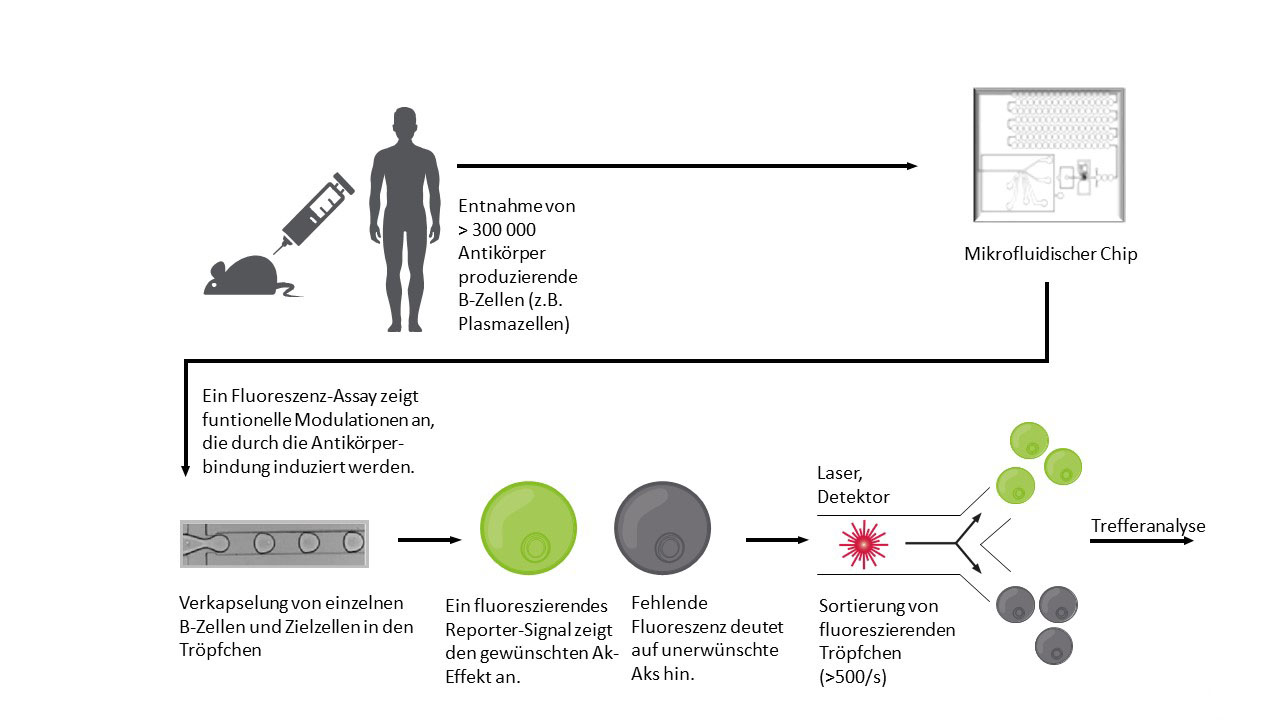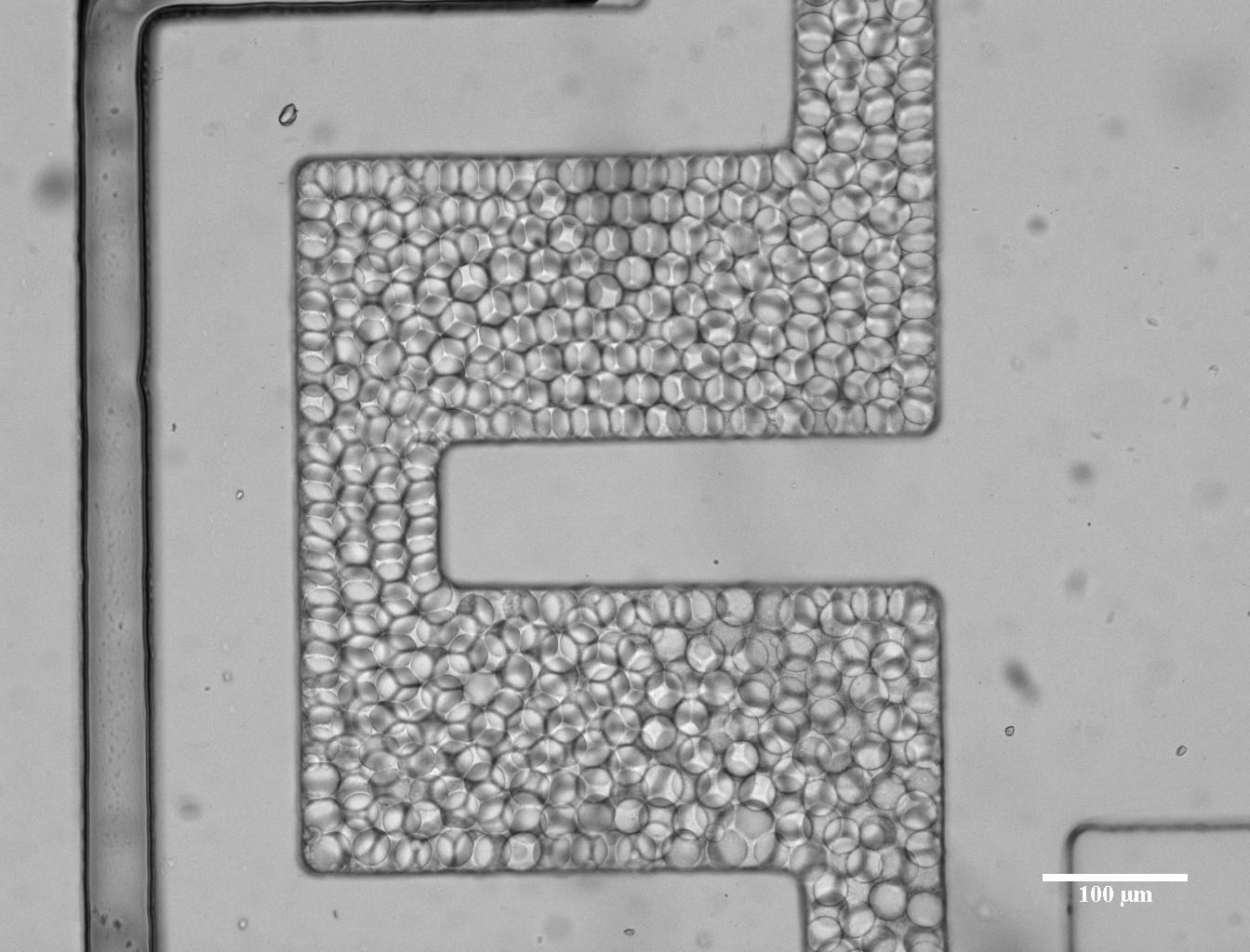Company profile
Velabs Therapeutics GmbH: each droplet is a test system
Using microfluidics to detect new therapeutic antibodies is, in simple terms, the concept developed by Velabs Therapeutics GmbH. The Heidelberg-based start-up was spun out from the European Molecular Biology Laboratory (EMBL) in 2017 with the support of EMBLEM Technology Transfer GmbH. More recently, investors have provided the young company with additional funding to expand its technologies and applications.
 Schematic representation of the microfluidic method for measuring functional antibodies. © Velabs
Schematic representation of the microfluidic method for measuring functional antibodies. © VelabsVelab's centrepiece is a microfluidics-based screening system for measuring antigen-antibody reactions. The system is a miniaturised liquid test method that packages each assay into its own droplet. The novel method is also differentiated from conventional test systems by its antigen-antibody measurement: rather than measuring the strength of the binding, Velabs’ microfluidic system measures the functionality of the desired antibody.
The new screening technology is currently used to search for new therapeutic antibodies for inflammatory diseases such as arthritis, Crohn's disease, ulcerative colitis, migraine, pain, as well as ovarian cancer and rare diseases. "Many other therapeutic and diagnostic applications can be conceived and will follow," says Velabs CEO, Christoph Antz.
The technology: droplet-based microfluidics
 Droplets are collected in a so-called "delay line" and released again after a short delay. © Velabs
Droplets are collected in a so-called "delay line" and released again after a short delay. © VelabsBefore the functionality of the antibodies can be measured, they obviously need to be produced. This is done by immunising a test animal with a target molecule, the specific antigen. The animal’s spleen is then removed and the antibody-producing B cells are isolated for further screening. Immunisation-free procedures are also possible. Antibodies from existing libraries (phages, yeast or hybridoma cells) can be used for this purpose.
A special method is used to package individual B cells into a single tiny droplet with a diameter of 20-100 micrometres. Once this is done, a reporter cell is introduced into the droplet. This cell has a "built-in" fluorescence test: if the desired functional (activating or inactivating) reaction between the antigen and the antibody takes place in the droplet, a fluorescence reaction occurs after excitation with light. This is recognised and quantified on the screening platform. Fluorescent droplets, known as hits, are sorted and collected, the B cells are isolated from the droplets and the antibodies produced are characterised.
 Fluorescent cells in droplets. A fluorescence reaction can occur when the antibody shows the desired effect. © Velabs
Fluorescent cells in droplets. A fluorescence reaction can occur when the antibody shows the desired effect. © VelabsIn this way, even the smallest amounts of starting material can be reliably analysed at tremendous speeds. "With our microfluidics-based high-throughput screening technology we can do hundreds of tests per second in real time. This saves us a huge amount of time," said Antz. "We use the technology primarily to look for antibodies against specialised membrane receptors such as G-protein coupled receptors (GPCRs) or ion channels - both of which are important regulators of cell-to-cell communication. More than 50 percent of all drugs worldwide are based on these two classes of molecules. But other target structures are also conceivable."
Own antibody collection and working with industry
Using the microfluidic method, Velabs is in the process of establishing its own antibody library with promising drug candidates for a variety of therapeutic applications. Most are "orphan GPCRs", which are GPCRs with an unknown ligand and unknown physiological function. "So far, little is known about this class. However, there is much to suggest that it has a critical role in the development of certain diseases," says Antz.
Velabs also offers licensing partnerships with pharmaceutical and life sciences companies. One example is a collaboration with a company called alytas therapeutics GmbH from Jena, announced in early September 2019. The cooperation partners are looking for functional antibodies for an immune-based therapy for obesity. Since April 2019, Velabs has been working with the Japanese company Chiome Bioscience to screen for antibodies against a specific GPCR. "These are just two examples," says Antz. "There are currently eight further cooperations under negotiation."
It is not just antibodies that can be quantified with the microfluidic platform. In collaboration with the BioMed X Innovation Center in Heidelberg, Velabs is using the system to analyse the role of T cells and their receptors for certain antigens in autoimmune disorders. The working group at the BioMed X Center is funded by Janssen Research & Development LLC.
On course for growth
As recently as June 2019, the Zurich-based company Xlife Sciences, an active investor in Velabs, made three million euros available for expanding the company’s antibody pipeline and screening platform, in what was the start of a further financing phase. Velabs will also be increasing its staff from eight to twelve by early 2020. "Velabs is on course for growth," says Antz. "The era of functional biologics is only just beginning. Functional antibodies will sustainably change the field of modern therapeutics. Especially in the treatment of chronic diseases, where therapeutic antibodies usually show a better spectrum of activity than standard methods, with fewer side effects."